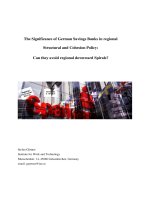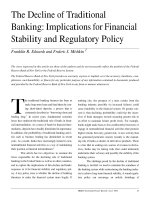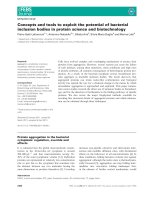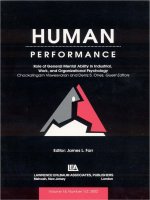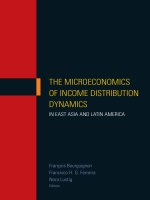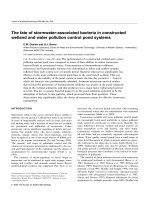The Microeconomics of Income Distribution Dynamics in East Asia and Latin America doc
Bạn đang xem bản rút gọn của tài liệu. Xem và tải ngay bản đầy đủ của tài liệu tại đây (2.37 MB, 439 trang )
THE MICROECONOMICS
OF INCOME DISTRIBUTION
DYNAMICS
IN EAST ASIA AND LATIN AMERICA
François Bourguignon
Francisco H. G. Ferreira
Nora Lustig
Editors
THE MICROECONOMICS OF
INCOME DISTRIBUTION
DYNAMICS IN EAST ASIA
AND LATIN AMERICATHE MICROECONOMICS OF
INCOME DISTRIBUTION
DYNAMICS IN EAST ASIA
AND LATIN AMERICA
François Bourguignon
Francisco H. G. Ferreira
Nora Lustig
Editors
A copublication of the World Bank and Oxford University Press
© 2005 The International Bank for Reconstruction and Development / The World Bank
1818 H Street, NW
Washington, DC 20433
Telephone: 202-473-1000
Internet: www.worldbank.org
E-mail:
All rights reserved.
First printing September 2004
1 2 3 4 08 07 06 05
A copublication of the World Bank and Oxford University Press.
Oxford University Press
198 Madison Avenue
New York, NY 10016
The findings, interpretations, and conclusions expressed herein are those of the author(s)
and do not necessarily reflect the views of the Board of Executive Directors of the World
Bank or the governments they represent.
The World Bank does not guarantee the accuracy of the data included in this work. The
boundaries, colors, denominations, and other information shown on any map in this
work do not imply any judgment on the part of the World Bank concerning the legal
status of any territory or the endorsement or acceptance of such boundaries.
Rights and Permissions
The material in this work is copyrighted. Copying and/or transmitting portions or all of
this work without permission may be a violation of applicable law. The World Bank
encourages dissemination of its work and will normally grant permission promptly.
For permission to photocopy or reprint any part of this work, please send a request
with complete information to the Copyright Clearance Center, Inc., 222 Rosewood
Drive, Danvers, MA 01923, USA, telephone 978-750-8400, fax 978-750-4470,
www.copyright.com.
All other queries on rights and licenses, including subsidiary rights, should be addressed
to the Office of the Publisher, World Bank, 1818 H Street, NW, Washington, DC 20433,
USA, fax 202-522-2422, e-mail
ISBN 0-8213-5861-8
Cataloging-in-Publication Data has been applied for.
Contents
Preface xiii
Acknowledgments xv
Contributors xvii
Abbreviations and Acronyms xix
1 Introduction 1
François Bourguignon, Francisco H. G. Ferreira,
and Nora Lustig
2 Decomposing Changes in the Distribution of
Household Incomes: Methodological Aspects 17
François Bourguignon and Francisco H. G. Ferreira
3 Characterization of Inequality Changes through
Microeconometric Decompositions: The Case of
Greater Buenos Aires 47
Leonardo Gasparini, Mariana Marchionni, and
Walter Sosa Escudero
4 The Slippery Slope: Explaining the Increase in
Extreme Poverty in Urban Brazil, 1976–96 83
Francisco H. G. Ferreira and Ricardo Paes de Barros
5 The Reversal of Inequality Trends in Colombia,
1978–95: A Combination of Persistent and
Fluctuating Forces 125
Carlos Eduardo Vélez, José Leibovich, Adriana
Kugler, César Bouillón, and Jairo Núñez
6 The Evolution of Income Distribution during
Indonesia’s Fast Growth, 1980–96 175
Vivi Alatas and François Bourguignon
7 The Microeconomics of Changing Income
Distribution in Malaysia 219
Gary S. Fields and Sergei Soares
v
8 Can Education Explain Changes in Income
Inequality in Mexico? 275
Arianna Legovini, César Bouillón, and Nora Lustig
9 Distribution, Development, and Education in Taiwan,
China, 1979–94 313
François Bourguignon, Martin Fournier, and
Marc Gurgand
10 A Synthesis of the Results 357
François Bourguignon, Francisco H. G. Ferreira, and
Nora Lustig
Index 407
Figures
3.1 Gini Coefficient of Equivalent Household Income
Distribution in Greater Buenos Aires, 1985–98 49
3.2 Hourly Earnings–Education Profiles for Men
(Heads of Household and Other Family
Members), Age 40 55
3.3 Hourly Earnings–Education Profiles for
Women (Spouses), Age 40 56
3.4 Weekly Hours of Work by Educational Level for
Men (Heads of Household), Age 40 59
4.1 Macroeconomic Instability in Brazil: Inflation 84
4.2 Macroeconomic Instability in Brazil: Per Capita GDP 84
4.3 Truncated Pen Parades, 1976–96 87
4.4 Plotted Quadratic Returns to Education
(Wage Earners) 88
4.5 Plotted Quadratic Returns to Experience
(Wage Earners) 89
4.6 Combined Price Effects by Sector 106
4.7 Price Effects Separately and for Both Sectors
Combined 107
4.8 Occupational-Choice Effects 108
4.9 The Labor Market: Combining Price and
Occupational-Choice Effects 109
4.10 Demographic Effects 110
4.11 Shift in the Distribution of Education, 1976–96 111
4.12 Education Endowment and Demographic Effects 112
4.13 A Complete Decomposition 113
5.1 Average Household Size by Income Decile in
Urban Colombia, Selected Years 135
vi
CONTENTS
5.2 Change in Income from Changes of Returns to
Education, Relative to Workers Who Have
Completed Secondary Education: Male and
Female Wage Earners in Urban Colombia,
Selected Periods 140
5.3 Change in Income from Changes of Returns to
Education, Relative to Workers Who Have
Completed Secondary Education: Male and
Female Self-Employed Workers in Urban
Colombia, Selected Periods 141
5.4 Probability of Being Employed or a Wage Earner
in Urban Colombia according to Various
Individual or Household Characteristics, Various
Groups of Household Members, Selected Years 146
5.5 Simulated Occupational-Choice and Participation
Changes in Percentage Points by Percentile of
Earnings for Urban Males and Females, 1978–88 154
5.6 Simulated Occupational-Choice and Participation
Changes in Percentage Points by Percentile of
Earnings for Urban Males and Females, 1988–95 156
5.7 Changes in Employment Rate by Income Percentile,
Females in Urban Colombia, Selected Periods 157
6.1 Summary Decomposition of Changes in the
Equivalized Household Distribution of Income 213
7.1 Changing Quantile Functions 221
7.2 Differences in Quantile Functions 222
7.3 Changing Lorenz Curves 224
7.4 Differences in Lorenz Curves 225
7.5 Household Quantile Curves: 1984 Baseline 253
7.6 Household Quantile Curves: 1989 Baseline 255
7.7 Quantile Curves: Simulated Values Minus 1984
Actual Values 257
7.8 Quantile Curves: Simulated Values Minus 1989
Actual Values 258
7.9 Lorenz Curves: Simulated Values Minus 1984
Actual Values 262
7.10 Lorenz Curves: Simulated Values Minus 1989
Actual Values 263
7.11 Household Quantile Curves: 1989 Baseline 265
7.12 Household Quantile Curves: 1997 Baseline 267
7.13 Quantile Curves: Simulated Values Minus 1989
Actual Values 269
7.14 Quantile Curves: Simulated Values Minus 1997
Actual Values 270
CONTENTS
vii
8.1 Observed Change in Individual Earnings by Percentile
in Mexico, 1984–94 276
8.2 Change in Women’s Labor-Force Participation by
Education Level in Mexico, 1984–94 281
8.3 Returns to Education for Men by Location,
Education Level, and Type of Employment in
Mexico, 1984 and 1994 292
8.4 Effect of Labor Choices on Earnings by Percentile
in Mexico, 1984–94 298
8.5 Effect of Educational Gains on Earnings by
Percentile in Mexico, 1984–94 300
8.6 Effect of Changes in Returns to Education on
Earnings by Percentile in Mexico, 1984–94 301
8.7 Effect of Urban-Rural Disparities on Earnings
by Percentile in Mexico, 1984–94 303
9.1 Evolution of Income Inequality, 1979–94 318
9.2 Elasticity of Spouses’ Occupational Choice with
Respect to Head of Household’s Earnings 332
9.3 1979–94 Variation in Individual Earnings Caused
by the Price Effect, by Centiles of the 1979 Earnings
Distribution 336
9.4 Simulated Entries into and Exits from the Wage
Labor Force 337
9.5 Simulation of the 1994 Education Structure on
the 1979 Population 340
9.6 1979–94 Variation in Household Income Caused by
the Price Effect, by Centiles of the 1979 Distribution of
Equivalized Household Income Per Capita (EHIP) 344
9.7 Entries into and Exits from the Labor Force: Overall
Participation Effect 345
9.8 Effects of Imposing the 1994 Education Structure
on the 1979 Population 348
9.9 Effects of Imposing the 1994 Children Structure on the
1979 Population: Relative Variation by Centile of the
1979 Distribution of Equivalized Household Income 351
Tables
1.1 Selected Indicators of Long-Run Structural Evolution 3
3.1 Distributions of Income in Greater Buenos
Aires, Selected Years 49
3.2 Hourly Earnings by Educational Levels in Greater
Buenos Aires, Selected Years 50
3.3 Log Hourly Earnings Equation Applied to
Greater Buenos Aires, Selected Years 52
viii
CONTENTS
3.4 Hourly Earnings by Gender in Greater Buenos Aires,
Selected Years 57
3.5 Weekly Hours of Work by Educational Levels in
Greater Buenos Aires, Selected Years 59
3.6 Hours of Work Equation for Greater Buenos Aires,
Selected Years 60
3.7 Labor Status by Role in the Household in Greater
Buenos Aires, Selected Years 62
3.8 Composition of Sample by Educational Level in
Greater Buenos Aires, Selected Years 63
3.9 Decompositions of the Change in the Gini Coefficient:
Earnings and Equivalent Household Labor Income in
Greater Buenos Aires, 1986–92 71
3.10 Decompositions of the Change in the Gini Coefficient:
Earnings and Equivalent Household Labor Income in
Greater Buenos Aires, 1992–98 72
3.11 Decompositions of the Change in the Gini Coefficient:
Earnings and Equivalent Household Labor Income in
Greater Buenos Aires, 1986–98 73
3.12 Decomposition of the Change in the Gini Coefficient:
Average Results Changing the Base Year in Greater
Buenos Aires, Selected Periods 74
4.1 General Economic Indicators for Brazil, Selected
Years 86
4.2 Basic Distributional Statistics for Different Degrees
of Household Economies of Scale 91
4.3 Stochastic Dominance Results 93
4.4 Educational and Labor-Force Participation Statistics,
by Gender and Race 94
4.5 Equation 4.2: Wage Earnings Regression for
Wage Employees 99
4.6 Equation 4.3: Total Earnings Regression for the
Self-Employed 101
4.7 Simulated Poverty and Inequality for 1976, Using
1996 Coefficients 104
4A.1 Real GDP and GDP Per Capita in Brazil, 1976–1996 115
4A.2 PNAD Sample Sizes and Missing or Zero Income
Proportions 116
4A.3 A Brazilian Spatial Price Index 117
4A.4 Brazilian Temporal Price Deflators, Selected Years 118
4A.5 Ratios of GDP Per Capita to PNAD Mean
Household Incomes, 1976–96 118
4B.1 Evolution of Mean Income and Inequality:
A Summary of the Literature 119
CONTENTS
ix
5.1 Decomposition of Total Inequality between Rural
and Urban Areas, Selected Years 129
5.2 Labor-Market Indicators in Urban and Rural
Areas, Selected Years 132
5.3 Changes in Sociodemographic Characteristics
in Urban and Rural Areas, Selected Years 134
5.4 Earnings Equations of Wage and Self-Employed
Male and Female Urban Workers, Selected Years 138
5.5 Earnings Equations of Wage and Self-Employed
Male and Female Rural Workers, Selected Years 139
5.6 Marginal Effect of Selected Variables on Occupational
Choice among Wage Earners, Self-Employed Workers,
and Inactive Individuals for Urban Heads of Household,
Spouses, and Other Household Members, and All
Rural Workers, Selected Years 144
5.7 Decomposition Income Distribution Changes for
Households and Individual Workers in Urban and
Rural Colombia: Changes in the Gini Coefficient,
Selected Periods 150
5.8 Mean Income: Effect of Change in the Constant of
the Earnings Equation 153
5.9 Simulated Changes in Participation and Occupational
Choice in Urban Colombia, Selected Periods 153
6.1 Evolution of Mean Household Income, 1980–96 178
6.2 Evolution of the Socioeconomic Structure of the
Population, 1980–96 179
6.3 Evolution of the Personal Distribution of Income,
1980–96 180
6.4 Individual Wage Functions by Gender and Area,
1980–96 186
6.5 Household Profit Functions and Nonfarm
Activities, 1980–96 188
6.6 Simulated Evolution of Typical Incomes: Price Effect 192
6.7 Decomposition of Changes in the Distribution of
Individual Earnings 194
6.8 Decomposition of Changes in the Distribution of
Household Income Per Capita 198
6.9 Mean and Dispersion of Household Incomes
according to Some Characteristics of Heads of
Households 200
6.10 Occupational-Choice Behavior, 1980–96 202
6.11 Simulated Changes in Occupational Choices,
Whole Population 205
x
CONTENTS
6.12 Simulated Changes in Occupational Choices, Rural
and Urban Population 206
7.1 Location of Actual Distribution of Per Capita
Household Income, 1984 and 1989, 1989 and 1997 223
7.2 Inequality of Actual Distribution of Per Capita
Household Income, Selected Periods 226
7.3 Occupational-Position Equations for Male Heads
of Household 231
7.4 Occupational-Position Equations for Female Heads
of Household 233
7.5 Occupational-Position Equations for Male Family
Members Who Are Not Heads of Household 235
7.6 Occupational-Position Equations for Female Family
Members Who Are Not Heads of Household 237
7.7 Earnings Functions for Male Wage Earners 240
7.8 Earnings Functions for Female Wage Earners 242
7.9 Earnings Functions for Male Self-Employed Workers 244
7.10 Earnings Functions for Female Self-Employed Workers 246
7.11 Distribution of Per Capita Household Income,
Substituting 1989 Values into 1984 Distribution 259
7.12 Distribution of Per Capita Household Income,
Substituting 1984 Values into 1989 Distribution 260
7.13 Rising Educational Attainments in Malaysia, 1984–97 261
7.14 Actual and Simulated Inequality for Disaggregated
Gender and Occupational-Position Groups 264
7.15 Distribution of Per Capita Household Income,
Substituting 1997 Values into 1989 Distribution 271
7.16 Distribution of Per Capita Household Income,
Substituting 1989 Values into 1997 Distribution 272
8.1 Inequality in Earnings and Household Income in
Mexico, 1984 and 1994 277
8.2 Characteristics of the Labor Force in Mexico, 1984
and 1994 279
8.3 Selected Results from Earnings Equations for Mexico 290
8.4 Decomposition of Changes in Inequality in Earnings
and Household Income in Mexico, 1984–94 295
8.5 Rural Effect in the Decomposition of Changes in
Inequality in Earnings and Household Income in
Mexico, 1984–94 297
9.1 Evolution of the Structure of the Population at
Working Age, 1979–94 316
9.2 Wage Functions for Men, Corrected for Selection
Bias, Selected Years 327
CONTENTS
xi
9.3 Wage Functions for Women, Corrected for Selection
Bias, Selected Years 328
9.4 Decomposition of the Evolution of the Inequality of
Individual Earnings, 1979–80 and 1993–94 334
9.5 Decomposition of the Evolution of the Inequality
of Equivalized Household Incomes, 1979–80 and
1993–94 335
10.1 A Summary of the Decomposition Results 359
10.2 Interpreting the Decompositions: A Schematic
Summary 381
xii
CONTENTS
Preface
The process of economic development is inherently about change.
Change in where people live, in what they produce and in how they
produce it, in how much education they get, in how long and in
how well they live, in how many children they have, and so on. So
much change, and the fact that at times it takes place at such sur-
prising speed, must affect the way incomes and wealth are distrib-
uted, as well as the overall size of the pie. While considerable efforts
have been devoted to the understanding of economic growth, the
economic analysis of the mechanisms through which growth and
development affect the distribution of welfare has been rudimentary
by comparison. Yet understanding development and the process of
poverty reduction requires understanding not only how total income
grows within a country but also how its distribution behaves over
time.
Our knowledge of the dynamics of income distribution is
presently limited, in part because of the informational inefficiency
of the scalar inequality measures generally used to summarize dis-
tributions. Single numbers can often hide as much as they show. But
recent improvements in the availability of household survey data for
developing countries, and in the capacity of computers to process
them, mean that we should be able to do a better job comprehend-
ing the nature of changes in the income distribution that accompany
the process of economic development. We hope that this book is a
step in that direction.
By looking at the evolution of the entire distribution of income
over reasonably long periods—10 to 20 years—and across a diverse
set of societies—four in Latin America and three in East Asia—we
have learned a great deal about a variety of development experi-
ences, and how similar building blocks can combine in unique ways,
to shape each specific historical case. But we have also learned about
the similarities in some of those building blocks: the complex effect
of educational expansion on income inequality, the remarkable role
of increases in women’s participation in the labor force, and the
importance of reductions in family size, to name a few.
xiii
We have learned that the complexity of the interactions between
these forces is so great that aggregate approaches to the relationship
between growth and distribution are unlikely to be of much use for
any particular country. We have also learned that some common
patterns can be discerned and, with appropriate care and humility,
understanding them might be helpful to policymakers seeking to
enhance the power of development to reduce poverty and inequity.
We hope that readers might share some of the joy we found in
uncovering the stories behind the distributional changes in each of
the countries studied in this book.
François Bourguignon
Francisco H. G. Ferreira
Nora Lustig
xiv
PREFACE
Acknowledgments
This book started as a joint research project organized by the Inter-
American Development Bank (IDB) and the World Bank, and we
are grateful to the many people in both institutions who supported
it throughout its five-year lifespan. We would like to thank particu-
larly Michael Walton, who supported the birth of the project when
he directed the Poverty Reduction Unit at the World Bank, as well
as Carlos Jarque and Carlos Eduardo Vélez of the IDB, who sup-
ported the project’s completion.
We are also very grateful to Martin Ravallion, who commented
on various versions of the work, from research proposal to finished
papers; to James Heckman, who acted as a discussant for three
chapters at a session in the 2000 Meetings of the American Eco-
nomic Association; to Ravi Kanbur, who provided very useful sug-
gestions at an early stage of the research process; and to Tony
Shorrocks, who gave us many insights into the nature of the decom-
positions we undertook. We are similarly indebted to a number of
participants in seminars and workshops that took place at various
meetings of the Econometric Society (in particular in Latin America
and the Far East); of the European Economic Association (in
Venice); of the Network on Inequality and Poverty of the IDB, World
Bank, and LACEA (Latin American and Caribbean Economic
Association); and at the Universities of Brasília, Maryland, and
Michigan, The Catholic University of Rio de Janeiro, the European
University Institute in Florence, and DELTA (Département et
Laboratoire d’Economie Théorique et Appliquée) in Paris.
Our greatest debt, of course, is to the authors of the seven case
studies, who really wrote the book. Their names and affiliations are
listed separately in the coming pages, and we thank them profoundly
for their commitment and endurance during the long process of pro-
ducing this volume. Finally, the book would not have been possible
without the dedication, professionalism, and attention to detail of
Janet Sasser and her team at the World Bank’s Office of the Publisher.
xv
Vivi Alatas Economist in the East Asia and
Pacific Region at the World Bank,
Jakarta, Indonesia
César Bouillón Economist in the Poverty and
Inequality Unit of the Inter-American
Development Bank, Washington, D.C.
François Bourguignon Senior vice president and chief econo-
mist of the World Bank, Washington,
D.C.
Walter Sosa Escudero Professor of econometrics at the Uni-
versidad de los Andes, Buenos Aires,
Argentina, and at the Universidad
Nacional de La Plata, Argentina;
researcher at Centro de Estudios
Distributivos, Laborales y Sociales
(CEDLAS) at the Universidad
Nacional de La Plata
Francisco H. G. Ferreira Senior economist in the Development
Research Group at the World Bank,
Washington, D.C.
Gary S. Fields Professor of labor economics at
Cornell University, Ithaca, New York
Martin Fournier Researcher at the Centre d’Etudes
Français sur la Chine Contemporaine
(CEFC), Hong Kong, China, and
associate professor at the Université
d’Auvergne, Clermont-Ferrand,
France
Leonardo Gasparini Director of CEDLAS, as well as pro-
fessor of economics of income distrib-
ution and professor of labor econom-
ics at the Universidad Nacional de La
Plata, Argentina
xvii
Marc Gurgand Researcher at the Département et
Laboratoire d’Economie Théorique et
Appliquée (DELTA) at the Centre
National de la Recherche Scientifique
(CNRS), Paris, France
Adriana Kugler Associate professor of economics at
the Universitat Pompeu Fabra,
Barcelona, Spain, and assistant pro-
fessor of economics at the University
of Houston, Texas
Arianna Legovini Senior monitoring and evaluation
specialist in the Africa Region at the
World Bank, Washington, D.C.
José Leibovich Assistant director of the Departamento
Nacional de Planeación (Department
of National Planning), Bogotá,
Colombia
Nora Lustig President of the Universidad de Las
Americas, Puebla, Mexico
Mariana Marchionni Professor of econometrics at the
Universidad Nacional de La Plata,
Argentina, and researcher at CEDLAS
Jairo Núñez Researcher at the Universidad de los
Andes, Bogotá, Colombia
Ricardo Paes de Barros Researcher at the Instituto de
Pesquisa Econômica Aplicada (IPEA),
Rio de Janeiro, Brazil
Sergei Soares Senior education economist in the
Latin America and Caribbean Region
at the World Bank, Washington,
D.C., and researcher at IPEA, Rio de
Janeiro, Brazil
Carlos Eduardo Vélez Chief of the Poverty and Inequality
Unit at the Inter-American Develop-
ment Bank, Washington, D.C.
xviii
CONTRIBUTORS
Abbreviations and Acronyms
CPI Consumer price index
DANE Departamento Nacional de Estadística (National
Department of Statistics, Colombia)
DGBAS Directorate-General of Budget, Accounting, and
Statistics (Taiwan, China)
EH Encuesta de Hogares (Household Survey,
Colombia)
EHIP Equivalized household income per capita
ENIGH Encuesta Nacional de Ingresos y Gastos de los
Hogares (Household Income and Expenditure
Surveys, Mexico)
EPH Encuesta Permanente de Hogares (Permanent
Household Survey, Argentina)
GDP Gross domestic product
IBGE Instituto Brasileiro de Geografia e Estatística
(Brazilian Geographical and Statistical Institute)
ICV-DIEESE Índice do Custo de Vida–Departamento
Intersindical de Estatística e Estudos Sócio-
Econômeios (Cost of Living Index–Inter Trade
Union Department of Statistics and Socioeco-
nomic Studies, Brazil)
IGP-DI Índice Geral de Preços–Disponibilidade Interna
(General Price Index, Brazil)
INEGI Instituto Nacional de Estadística, Geografia y
Informática (National Institute of Statistics,
Geography, and Informatics, Mexico)
INPC-R Índice Nacional de Preços ao Consumidor–Real
(National Consumer Price Index, Brazil)
MIDD Microeconomics of Income Distribution
Dynamics
xix
OLS Ordinary least squares
PNAD Pesquisa Nacional por Amostra de Domicílios
(National Household Survey, Brazil)
Progresa Programa de Educación, Salud y Alimentación
(Program for Education, Heath, and Nutrition,
Mexico)
xx
ABBREVIATIONS AND ACRONYMS
1
Introduction
François Bourguignon,
Francisco H. G. Ferreira, and Nora Lustig
This book is about how the distribution of income changes during
the process of economic development. By its very nature, the process
of development is replete with structural change. The composition of
economic activity changes over time, generally away from agriculture
and toward industry and services. Relative prices of goods and factors
of production change too, and their dynamics involve both long-term
trends and short-term shocks and fluctuations. The sociodemo-
graphic characteristics of the population evolve, as average age rises
and average family size falls. Patterns of economic behavior are not
constant either: female labor-force participation rates increase, as do
the ages at which children leave school and enter employment.
Generations save, invest, and bequeath, and so holdings of both phys-
ical and human capital change. But although change is everywhere
and although some patterns can be discerned across many societies,
no single country ever follows exactly the same development path.
The combination, sequence, and timing of changes that are actually
observed in any given country, at any given period, are always unique,
always unprecedented.
Each one of these processes of structural change is likely to have
powerful effects on the distribution of income. Social scientists in
general—and economists in particular—have long been searching
for some general rule about how development and income distribu-
tion dynamics are related. Karl Marx (1887) concluded that, under
the inherent logic of capital accumulation by a few and relentless
1
competition in labor supply by many, social cleavages would grow
increasingly deeper, until revolution changed things forever. Simon
Kuznets (1955)—drawing on W. Arthur Lewis (1954)—believed
that the migration of labor and capital from traditional, less pro-
ductive sectors of the economy toward more modern and produc-
tive ones would result first in rising inequality, followed eventually
by declining inequality. Jan Tinbergen (1975) argued that the cru-
cial struggle in modern economies was that between the rival forces
of (a) technological progress—ever raising the demand for (and the
pay of) more educated workers—and (b) educational expansion—
ever raising the supply of such workers. More recently, economists
have developed models with multiple equilibria, each characterized
by its own income distribution, with its own mean and its own level
of inequality.
1
These models show that different combinations of
initial conditions—and of the historical processes that might follow
them—could lead to diverse outcomes.
In this book, we do not suggest yet another grand theory of the
dynamics of income distribution during the process of development.
Instead, we propose and apply a methodology to decompose distri-
butional change into its various driving forces, with the aim of
enhancing our ability to understand the nature of income distribu-
tion dynamics.
2
In fact, rather than searching for a unifying expla-
nation, we explore the incredible diversity in the distributional
experiences and outcomes across economies. Why do changes in
inequality differ so markedly across economies that have similar
rates of growth in gross domestic product (GDP) per capita, such as
Colombia and Malaysia (see table 1.1)? Why do we observe rising
inequality both in growing economies (Mexico) and in contracting
ones (Argentina)? Why do educational expansions sometimes lead
to greater equality (as in Brazil and Taiwan, China) and sometimes
to greater inequality (as in Indonesia and Mexico)?
The microeconomic empirics reported in this volume suggest that
this diversity in outcomes results from the various possibilities that
arise from the interaction of a number of powerful underlying social
and economic phenomena. We group these phenomena into three
fundamental forces: (a) changes in the underlying distribution of
assets and personal characteristics in the population (which includes
its ethnic, racial, gender, and educational makeup); (b) changes in
the returns to those assets and characteristics; and (c) changes in
how people use those assets and characteristics, principally in the
labor market.
At a general level, our approach to addressing these themes con-
sists of simulating counterfactual distributions by changing how
markets and households behave, one aspect at a time, and by observ-
ing the effect of each change on the distribution, while holding all
2
BOURGUIGNON
,
FERREIRA
,
AND LUSTIG
3
Table 1.1 Selected Indicators of Long-Run Structural Evolution
Indicator Argentina
a
Brazil Colombia Indonesia Malaysia Mexico Taiwan, China
Period analyzed 1986–98 1976–96 1978–95 1980–96 1984–97 1984–94 1979–94
GDP per capita in 1980
(purchasing power parity in US$) 6,506 4,499 2,520 1,430 5,548 5,758 3,786
Annual growth rate of GDP
per capita (1980–96, percent) 0.0 1.0 3.7 5.7 4.0 2.4 6.0
Growth rate of mean household
per capita income
b
(percent) −1.0 0.2 3.8 5.1 5.2 1.1 5.7
Average years of schooling
Initial year 8.7
c
3.2 4.6 3.8 7.9
c
5.6 6.0
Terminal year 9.8
c
5.3 6.9 6 8.3
c
6.9 9.5
Urbanization rate (percent)
Initial year 86 68 57 23 42 63 70
Terminal year 88 77 61 35 55 58 84
Participation of women in the
labor force (percent)
Initial year 45 28 27 32 60 33 46
Terminal year 56 42 41 48 58 41 50
Family size
Initial year 4.4 4.6 5.4 5.0 4.9 5.3 4.9
Terminal year 4.4 3.6 4.3 4.4 4.4 4.9 4.2
Gini coefficient (household
income per capita, size-
weighted households)
Initial year 0.417 0.595
d
0.502
d
0.384 0.486 0.491 0.271
Terminal year 0.501 0.591
d
0.544
d
0.402 0.499 0.549 0.290
a. Apart from the GDP and urbanization data, all Argentine data refer to Greater Buenos Aires only. b. As given by household surveys in initial and
terminal years. c. For population age 14 and over. d. Urban sector only.
other aspects constant. We construct a simple income generation
model at the household level, which allows us to separate the
observed changes in the distribution of income into the three key
forces just described. The first force comprises the changes in the
sociodemographic structure of the population, as characterized by
area of residence, age, education, ownership of physical and finan-
cial assets, and household composition (collectively referred to as
endowment effects, or population effects). The second force comes
from changes in the returns to factors of production, including the
various components of human capital, such as education and expe-
rience (price effects). The third force has to do with changes in the
occupational structure of the population, in terms of wage work,
self-employment, unemployment, and inactivity (occupational
effects).
Of course, those causes of changes in the distribution of income
are not independent of one another. For instance, a change in the
sociodemographic structure of the population—such as higher
education levels in some segments of the population—will proba-
bly generate a change in the structure of prices, wages, and self-
employment incomes, which may in turn modify the way people
choose among alternative occupations. Conversely, exogenous
changes in returns to education (say, from skill-biased technological
change) are likely to induce some response from households in terms
of the desired level of education for their children. Like all of its rel-
atives in the Oaxaca-Blinder class of decompositions, the technique
discussed in this volume is not designed to model those general equi-
librium effects. It simply separates out how much of a given change
would not have been observed under a well-defined statistical coun-
terfactual (for example, if returns to education had not changed),
without making any statement about the economic foundations
of that counterfactual (for example, the conditions under which
no change in the returns to education would be consistent with
the other observed changes, in an economic sense). Nevertheless, as
we hope the case studies in chapters 3 through 9 will show, the
insights gained from the statistical decomposition and some basic
microeconomic intuition allow analysts to improve their under-
standing of the nature of changes in income distribution in a partic-
ular economy.
The microeconometric approach applied in this volume should
be seen as complementary to the more prevalent macroeconometric
(cross-country) studies of the relationship between growth and
inequality (or the reverse). (See, for instance, Alesina and Rodrik
1994; Dollar and Kraay 2002; Forbes 2000.) Cross-country regres-
sions can, if well specified and run on comparable data, tell us much
about average relationships between measures of income dispersion
4
BOURGUIGNON
,
FERREIRA
,
AND LUSTIG
